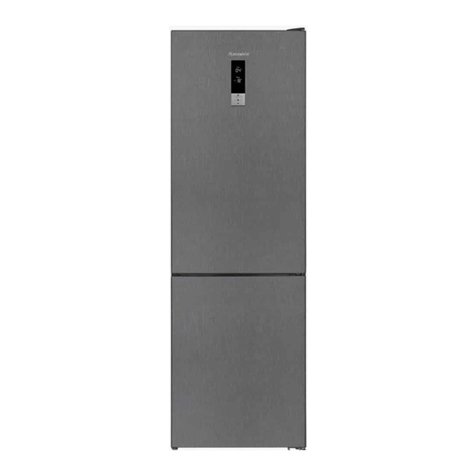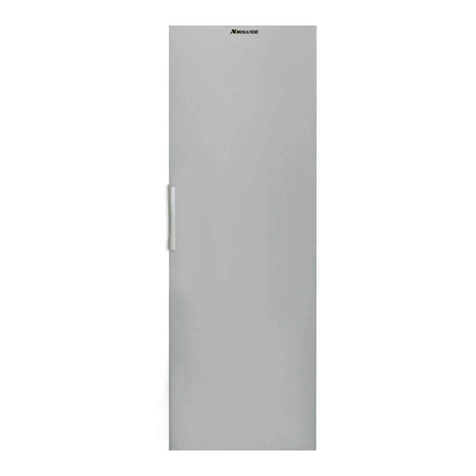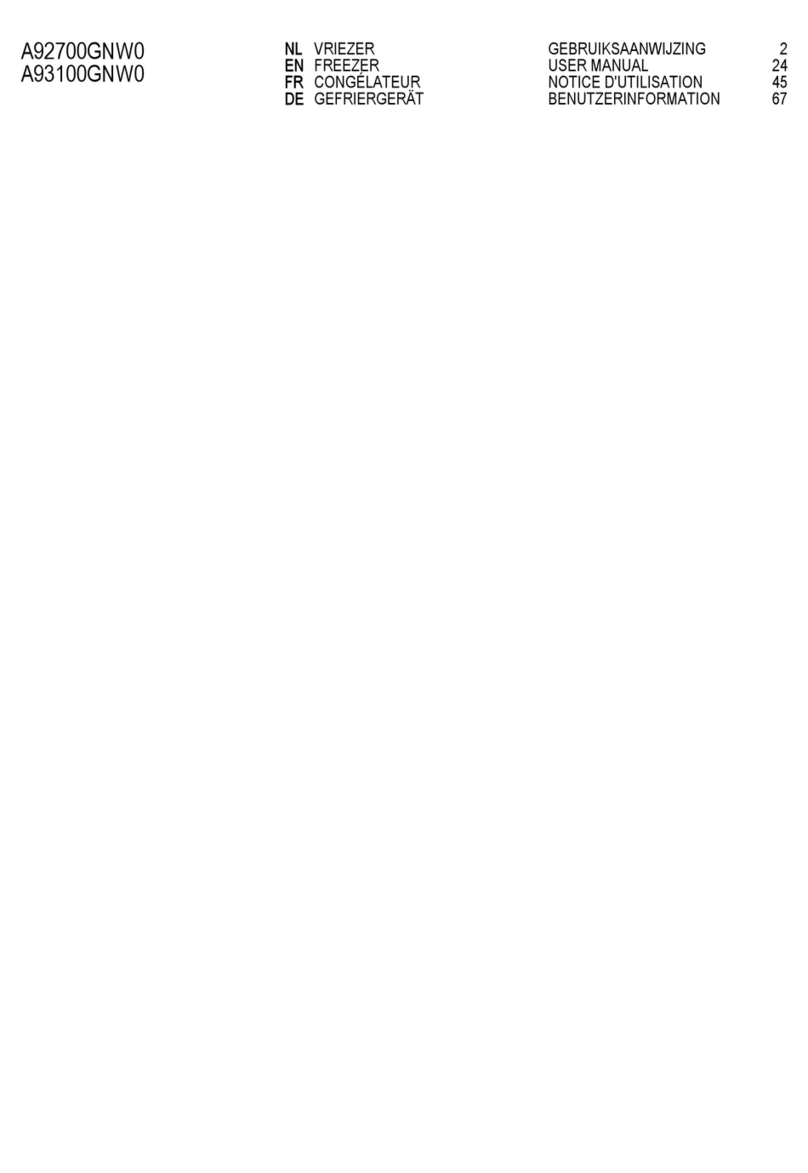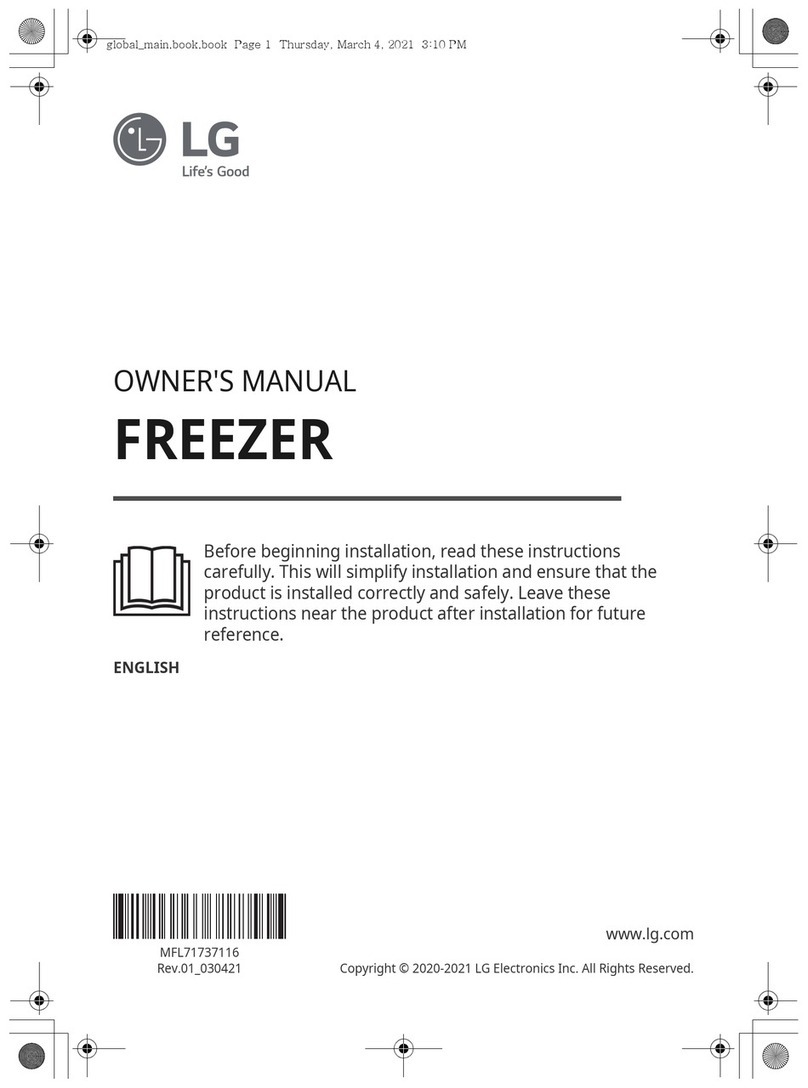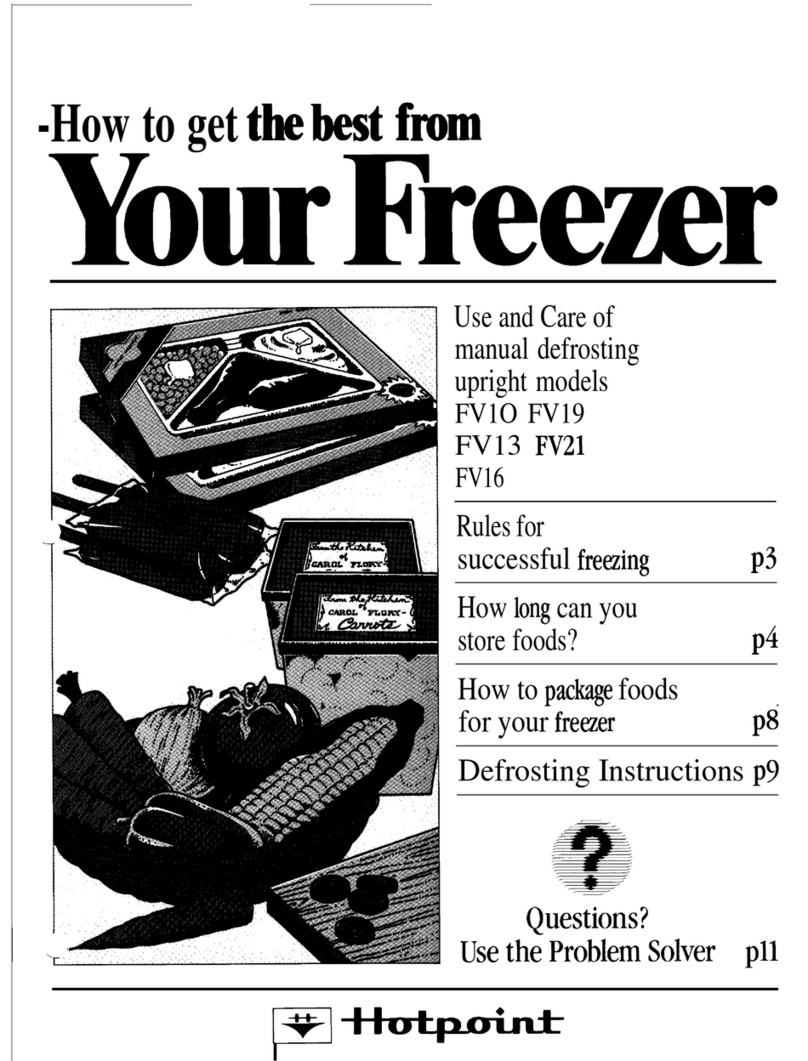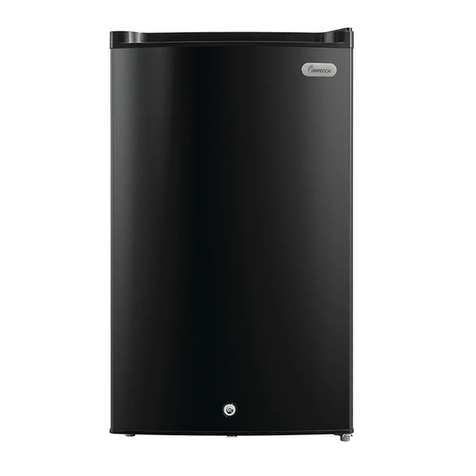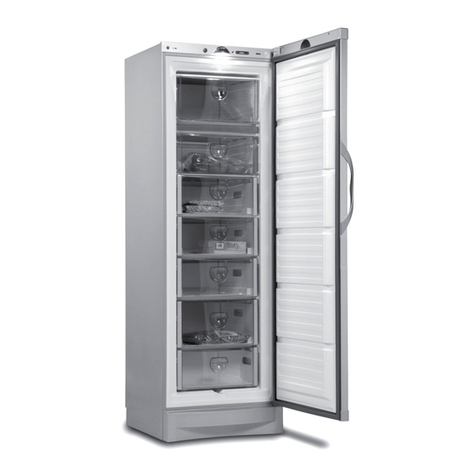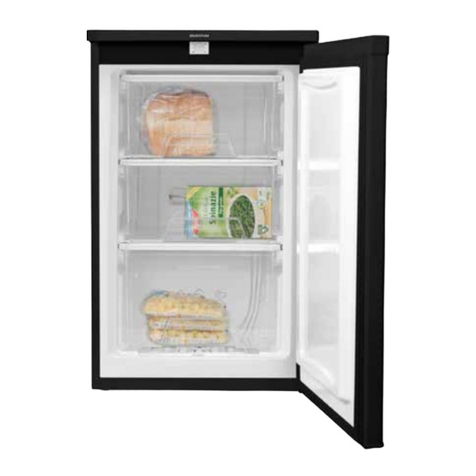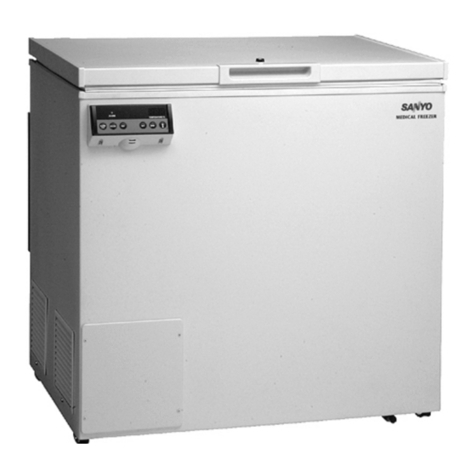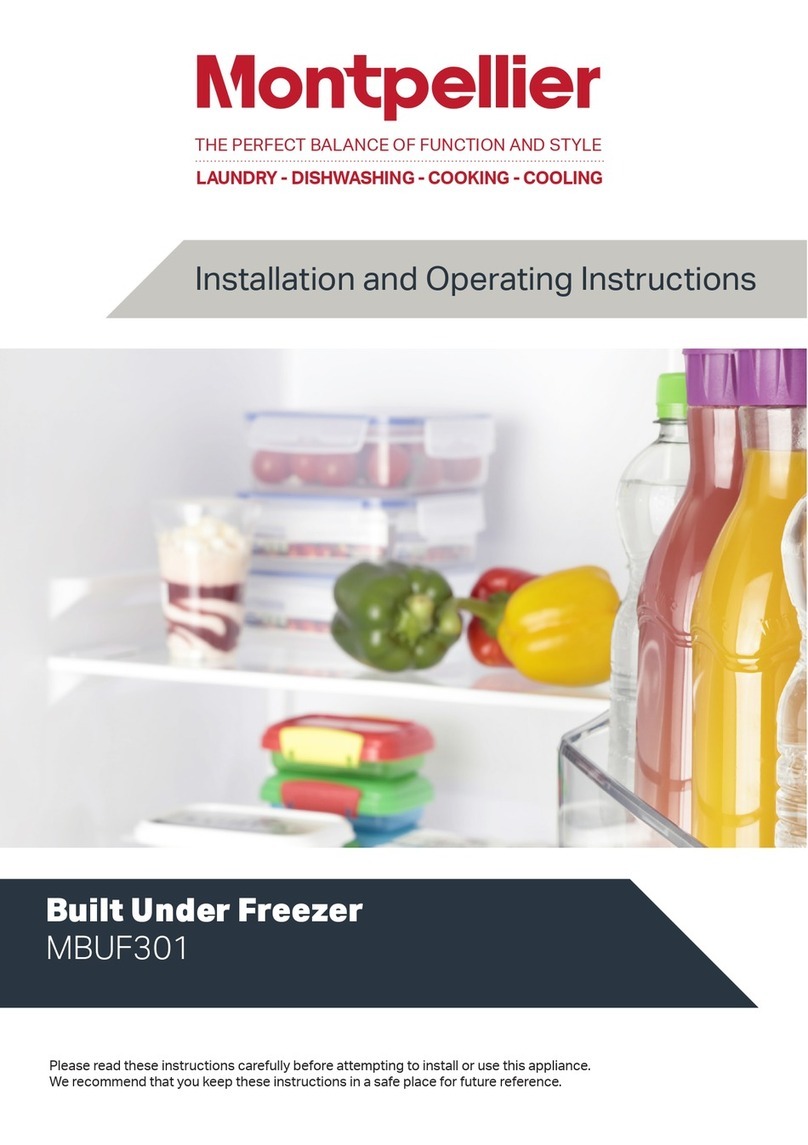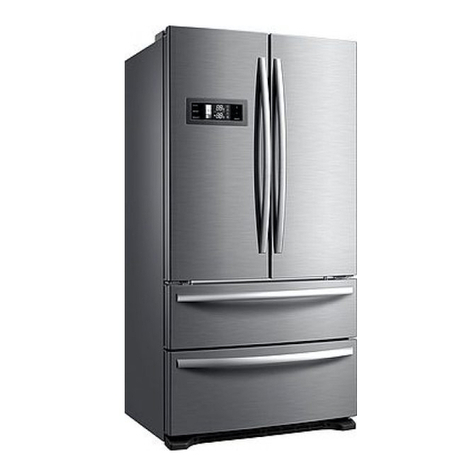Normande ND-351 User manual

Klinton
international trade 2000 LTD
בורזל8 :ןופלט , ןויצל ןושאר03-7212000 : סקפ03-7212022
FREEZER
User Manual
ND-351

EN -13-
THE PARTS OF THE APPLIANCE AND THE
COMPARTMENTS
PART 7.
1. Plastic scraper
2. Ice tray
3. Thermostat
4. Freezer upper room cover
5. Freezer bottom room cover
6. Freezer compartment drawers
7. Levelling Foot
This presentation is only for information about the parts of the appliance.
Parts may vary according to the appliance model.

EN -12-
Tips for saving energy
1. Install the appliance in a cool, well ventilated room , but not in direct sunlight and not
near a heat source (radiator, cooker.. etc). Otherwise use an insulating plate.
2. Allow warm food and drinks to cool down outside the appliance.
3. Cover drinks or other liquids when placing them in the appliance Otherwise humidity
increases in the appliance. Therefore, the working time gets longer. Also covering drinks
and other liquids helps to preserve smell and taste.
4. Try to avoid keeping the doors open for long periods or opening the doors too frequently
as warm air will enter the cabinet and cause the compressor to switch on unnecessarily
often.
5. Keep the covers of the different temperature compartments (crisper, chiller ...etc) closed
6. Door gasket must be clean and pliable. Replace gaskets if worn.

EN -11-
Repositioning the door
• It is not possible to change the opening direction of your freezer door, if the door handle
on your freezer is installed from the front surface of the door.
• It is possible to change the opening direction of the door on models without any handles.
• If the door opening direction of your freezer may be changed, you should contact the
nearest Authorised Service Agent to have the opening direction changed.
BEFORE CALLING YOU’RE AFTER SALES SERVICEPART 6.
If your freezer is not operating as expected, check the solutions listed below before calling
an electrician or the after sales service.
What to do if your appliance does not operate:
Check that:
• The thermostat setting is not on « • » position
• Your freezer is plugged in and switched on,
• The mains switch in your home is not switched off,
• The socket is no longer functioning. To check this, plug in an appliance that you know is
working into the same socket.
What to do if your appliance performs poorly:
Check that:
• You have not overloaded the appliance,
• The thermostat setting is not on « 1 » position,
• The doors are closed properly,
• There is no dust on the condenser,
• There is enough space for air circulation at the rear and side of the appliance.
If there is noise:
The cooling gas which circulates in the refrigerator circuit may make a slight noise (bubbling
sound) even when the compressor is not running. This is normal. If these sounds are different
check that:
• The appliance is well levelled
• Nothing is touching the rear
• Nothing on or in the appliance is vibrating.
Recommendations
• If the appliance is not used for long time (for example during holidays) defrost and clean
the refrigerator, leaving the door open to prevent the formation of midew and smell.
• To stop the appliance completely, unplug it from the mains socket (for cleaning and when
the doors are left open).
• If the problem persists after you have followed all the instructions above, please consult
the nearest Authorised Service.
• The appliance you have purchased is designed for home type use and can be used only
at home and for the stated purposes. It is not suitable for commercial or common use. If
the consumer use the appliance in a way that does not comply with these features, we
emphasise that the producer and the dealer shall not be responsible for any repair or
failure within the guarantee period.

EN -10-
Defrosting
Freezer defrosting process
• Small amounts of frost will accumulate inside the freezer, depending upon the length of
time for which the door is left open or the amount of moisture introduced. It is essential to
ensure that no frost or ice is allowed to form at places where it will affect the close tting
of the door seal. This might allow air to penetrate the cabinet, encouraging continuous
running of the compressor. Thin frost formation is quite soft and can be removed with
a brush or plastic scraper. Do not use metal or sharp scrapers, mechanical devices or
other means to accelerate the defrosting process. Remove all dislodged frost from the
cabinet oor. It is not necessary to switch off the appliance for the removal of this frost.
• For the removal of heavy ice deposits, disconnect the appliance from the mains supply,
empty the contents into cardboard boxes and wrap in thick blankets or layers of paper to
keep them cold. Defrosting will be most effective if carried out when the freezer is nearly
empty and should be carried out as quickly as possible to prevent undue increase in the
temperature of the contents.
• Do not use metal or sharp scrapers, mechanical devices or other means to accelerate
the defrosting process. An increase in temperature of frozen food during defrosting will
shorten the storage life. If the contents are well wrapped and placed in a cool area they
should keep for several hours.
• Dry the inside of the compartment with a
sponge or a clean cloth.
• To accelerate the defrosting process,
place one or more bowls of warm water in
the freezer compartment.
• Examine the contents when replacing them in the freezer and if some of the food has
thawed out it should be eaten within 24 hours, or be cooked and re-frozen.
• After defrosting has nished clean the inside of the appliance with a solution of warm
water with a little bicarbonate of soda and then dry thoroughly. Wash all removable parts
in the same way and reassemble. Reconnect the appliance to the mains supply and
leave for 2 to 3 hours on setting « 5 » position before introducing the food back into the
freezer.
TRANSPORTATION AND CHANGING OF
INSTALLATION POSITION
PART 5.
Transportation and changing of Installation position
• The original packages and foamed polystyrene (PS) can be retained if required.
• During transportation, the appliance should be secured with a wide string or a strong
rope. The instructions written on the corrugated box must be followed while transporting.
• Before transporting or changing the installation position,
all the moving objects (ie, ice tray, scraper, drawers …)
should be taken out or xed with bands in order to prevent
them from getting damaged.
!Carry your fridge in the upright position.

EN -9-
• Frozen food should be transported in appropriate containers to maintain the quality of the
food and should be returned to the freezing surfaces of the unit in the shortest possible
time.
• If a package of frozen food shows the sign of humidity and abnormal swelling it is
probable that it has been previously stored at an unsuitable temperature and that the
contents have deteriorated.
• The storage life of frozen food depends on the room temperature, thermostat setting, how
often the door is opened, the type of food and the length of time required to transport
the product from the shop to your home. Always follow the instructions printed on the
packaging and never exceed the maximum storage life indicated.
• While freezing food, the maximum amount of fresh food (in kg) that can be frozen in 24
hours is indicated on the appliance label.
CLEANING AND MAINTENANCEPART 4.
• Disconnect the unit from the power supply before cleaning.
• Do not wash your freezer by pouring water on it.
• Make sure that no water enters the lamp housing and other electrical
components.
• The freezer should be cleaned periodically using a solution of
bicarbonate of soda and lukewarm water.
• Clean the accessories separately with soap and water Do not
clean them in the dishwasher.
• Do not use abrasive products, detergents or soaps. After washing, rinse
with clean water and dry carefully. When you have nished cleaning,
reconnect the plugto the mains supply with dry hands.
• Clean the condenser with a broom at least twice a year. This will
help you to save on energy costs and increase productivity.
!The power supply must be disconnected.

EN -8-
Plastic scraper
After a period of time frost will build up in certain areas in the freezer compartment.
The frost accumulated in the freezer should be removed periodically. Use the
plastic scraper provided if necessary. Do not use sharp metal objects for this
operation. They could puncture the refrigerator circuit and cause irreparable
damage to the unit.
Warnings for temperature settings
• The ambient temperature, temperature of the freshly stored food and how often the door
is opened, affects the temperature in the freezer. If required,change the temperature
setting.
• It is not recommended that you operate your freezer in environments colder than 10°C.
• The temperature setting should be set by taking into consideration how often the freezer
door is opened and closed, how much food is stored in the freezer and the environment
in which and the positioning of the appliance.
• We recommend that when rst using the freezer it should be left running for 24 hours
uninterrupted to ensure it is completely cooled. Do not open the freezer door, or put
food inside for this period.
• Your freezer has a 5 minute built in delay function, designed to prevent damage to the
compressor. When power is applied to your freezer, it will begin to operate normally after
5 minutes.
• Your freezer is designed to operate in the ambient temperature intervals stated in
the standards, according to the climate class stated in the information label. It is not
recommended that your freezer is
operated in the environments which are
out of the stated temperature intervals
in terms of cooling efciency.
• This appliance is designed for use at an
ambient temperature within the 10°C -
43°C range.
Climate class Ambient Temperature (oC)
TBetween 16 and 43 oC
ST Between 16 and 38 oC
NBetween 16 and 32 oC
SN Between 10 and 32 oC
Visual and text descriptions on the accessories section may
vary according to the model of your appliance.
ARRANGING FOOD IN THE APPLIANCEPART 3.
• The freezer compartment is used for freezing fresh food, for storing frozen foods for the
period of time indicated on packaging and for making ice cubes.
• Do not put fresh and warm food next to frozen food as it can thaw the frozen food.
• Do not put fresh and warm foods to the freezer door shelves to be frozen. Only use the
door shelves for storing frozen foods.
• While freezing fresh foods (i.e. meat, sh and mincemeat) divide them in portions you
will use in a single serving.
• For storing frozen foods, the instructions shown on frozen food packages should always
be followed carefully. If no information is provided, food should not be stored for more
than 3 months from the purchased date.
• When buying frozen food ensure that these have been frozen at suitable temperatures
and that the packing is intact.

EN -7-
Before using your freezer
• When using your freezer for the rst time, or after transportation, keep it in
an upright position for at least 3 hours before plugging into the mains. This
allows efcient operation and prevents damage to the compressor.
• Your freezer may have a smell when it is operated for the rst time. This is normal and
the smell will fade away when your freezer starts to cool.
USING YOUR FREEZERPART 2.
Thermostat setting
Freezer thermostat automatically regulates the inside temperature of the compartments. By
rotating the knob from position “1” to “5”, colder temperatures can be obtained.
Important note: Do not try to rotate knob beyond 1 position it will stop your appliance.
Freezer Thermostat Setting;
1 - 2 : For short-term storage of food in the freezer compartment, you can set the knob
between minimum and medium position.
3 - 4 : For long-term storage of food in the freezer compartment, you can set knob medium
position.
5:For freezing the fresh food. The appliance will run for colder temperatures.
Note that
• The ambient temperature, temperature of the freshly stored food and how often the door
is opened, affects the temperature in the freezer compartment. If required, change the
temperature setting.
• For best internal temperature the indicator in the freezer thermostat should be positioned
between 2 and 4.
Accesories
Making Ice cubes (Ice tray)
• Fill the ice tray with water and place in the freezer compartment.
• After the water has completely turned into ice, you can twist the tray as shown below to
remove the ice cubes.

EN -6-
• Do not place glass bottles or beverage cans in the ice-making
compartment as they can burst as the contents freeze.
• Do not place explosive or ammable material in your freezer. Place
drinks with high alcohol content vertically in the freezer and make sure
that their tops are tightly closed.
• When removing ice from the ice-making compartment, do not touch it. Ice may
cause frost burns and/or cuts.
• Do not touch frozen goods with wet hands. Do not eat ice-cream or ice cubes immediately
after you have taken them out of the ice-making compartment.
• Do not re-freeze frozen goods after they have melted. This may cause health issues such
as food poisoning.
• Do not cover the body or top of freezer with lace. This affects the performance of your
freezer.
• Secure any accessories in the freezer during transportation to prevent damage to the
accessories.
• Do not use plug adapter.
Installing and operating your freezer
Before starting to use your freezer, you should pay attention to the following points:
• The operating voltage for your freezer is 220-240 V at 50Hz.
• We do not accept responsibility for any damages that occur due to ungrounded usage.
• Place your freezer where it will not be exposed to direct sunlight.
• Your appliance should be at least 50 cm away from stoves, gas ovens and heater cores,
and at least 5 cm away from electrical ovens.
• Your freezer should never be used outdoors or exposed to rain.
• When your freezer is placed next to a deep freezer, there should be at least
2 cm between them to prevent humidity forming on the outer surface.
• Do not place heavy items on the appliance.
• Do not place anything on your freezer, and install your freezer in a suitable
place so that at least 15 cm of free space is available above it.
• Use the adjustable front legs to make sure your appliance is level and
stable. You can adjust the legs by turning them in either direction. This should be done
before placing food in the freezer.
• Before using your freezer, wipe all parts with a solution of warm water
and a teaspoon of sodium bicarbonate, then rinse with clean water and
dry. Place all parts in the freezer after cleaning.
• Install the plastic distance guide (the part with black vanes at the rear)
by turning it 90° (as shown in the gure) to prevent the condenser from
touching the wall.
• The freezer should be placed against a wall with a free space not
exceeding 75 mm.

EN -5-
Old and out-of-order fridges
• If your old fridge has a lock, break or remove the lock before discarding it, because
children may get trapped inside it and may cause an accident.
• Old fridges and freezers contain isolation material and refrigerant with CFC. Therefore,
take care not to harm environment when you are discarding your old fridges.
Disposal of your old appliance
This symbol on the product or package implies that the product should not
be treated as domestic waste. Instead, it should be delivered to applicable
waste collection places recycling electrical and electronic equipment. You will
contribute to avoid potential negative results regarding environment and human
health, which will arise due to wrong waste procedure for the product by ensuring
that this product is annihilated properly. Recycling materials will help natural
resources be preserved. For more detailed information regarding recycling of this product,
please contact local municipality, domestic waste annihilation service or the shop you have
purchased the product.
Please ask your municipal authority about the disposal of the WEEE for the reuse, recycle
and recovery purposes.
Notes:
• Please read the instruction manual carefully before installing and using your appliance.
We are not responsible for the damage occurred due to misuse.
• Follow all instructions on your appliance and instruction manual, and keep this manual in
a safe place to resolve the problems that may occur in the future.
• This appliance is produced to be used in homes and it can only be used in domestic
environments and for the specied purposes. It is not suitable for commercial or
common use. Such use will cause the guarantee of the appliance to be cancelled and
our company will not be responsible for the losses to be occurred.
• This appliance is produced to be used in houses and it is only suitable for cooling / storing
foods. It is not suitable for commercial or common use and/or for storing substances
except for food. Our company is not responsible for the losses to be occurred in the
contrary case.
Safety warnings
• Do not connect your freezer to the mains electricity supply using an extension lead.
• Do not plug in damaged, torn or old plugs.
• Do not pull, bend or damage the cord.
• This appliance is designed for use by adults, do not allow children to play
with the appliance or let them hang off the door.
• Never touch the power cord/plug with wet hands as this could cause a
short circuit or electric shock.

EN -4-
can use appliances safely after they have been given
appropriate supervision or instruction concerning use of the
appliance. Very vulnerable people are not expected to use
appliances safely unless continuous supervision is given.
• If the supply cord is damaged, it must be replaced by the
manufacturer, an authorised service agent or similar qualied
persons, in order to avoid a hazard.
• This appliance is not intended for use at altitudes exceeding
2000 m.
To avoid contamination of food, please respect the
following instructions:
• Opening the door for long periods can cause a signicant
increase of the temperature in the compartments of the
appliance.
• Clean regularly surfaces that can come in contact with food
and accessible drainage systems.
• Store raw meat and sh in suitable containers in the
refrigerator, so that it is not in contact with or drip onto other
food.
• Two-star frozen-food compartments are suitable for storing
pre-frozen food, storing or making ice cream and making ice
cubes.
• One-, two- and three-star compartments are not suitable for
the freezing of fresh food.
• If the refrigerating appliance is left empty for long periods,
switch off, defrost, clean, dry, and leave the door open to
prevent mould developing within the appliance.

EN -3-
a ammable propellant in this appliance.
• This appliance is intended to be used in household and
domestic applications such as:
- staff kitchen areas in shops, ofces and other working en-
vironments.
- farm houses and by clients in hotels, motels and other resi-
dential type environments.
- bed and breakfast type environments;
- catering and similar non-retail applications.
• If the socket does not match the refrigerator plug, it must be
replaced by the manufacturer, a service agent or similarly
qualied persons in order to avoid a hazard.
• A specially grounded plug has been connected to the power
cable of your refrigerator. This plug should be used with
a specially grounded socket of 16 amperes. If there is no
such socket in your house, please have one installed by an
authorised electrician.
• This appliance can be used by children aged from 8 years
and above and persons with reduced physical, sensory or
mental capabilities or lack of experience and knowledge if
they have been given supervision or instruction concerning
use of the appliance in a safe way and understand the hazards
involved. Children shall not play with the appliance. Cleaning
and user maintenance shall not be made by children without
supervision.
• Children aged from 3 to 8 years are allowed to load and
unload refrigerating appliances. Children are not expected
to perform cleaning or user maintenance of the appliance,
very young children (0-3 years old) are not expected to use
appliances, young children (3-8 years old) are not expected
to use appliances safely unless continuous supervision is
given, older children (8-14 years old) and vulnerable people

EN -2-
General warnings
WARNING: Keep the ventilation openings of the Fridge Freezer
clear from obstruction.
WARNING: Do not use mechanical devices or other means
to accelerate the defrosting process, other than those recom-
mended by the manufacturer.
WARNING: Do not use electrical appliances inside the food
storage compartments of the appliance, unless they are of the
type recommended by the manufacturer.
WARNING: Do not damage the refrigerant circuit.
WARNING: In order to avoid any hazards resulting from the in-
stability of the appliance, it must be xed in accordance with the
following instructions:
WARNING: When positioning the appliance, ensure the supply
cord is not trapped or damaged.
WARNING: Do not locate multiple portable socket-outlets or
portable power supplies at the rear of the appliance.
SYMBOL ISO 7010 W021
Warning: Risk of re / ammable materials
• If your appliance uses R600a as a refrigerant (this information
will be provided on the label of the cooler) you should take care
during transportation and installation to prevent the cooler
elements from being damaged. R600a is an environmentally
friendly and natural gas, but it is explosive. In the event of a
leak due to damage of the cooler elements, move your fridge
away from open ames or heat sources and ventilate the
room where the appliance is located for a few minutes.
• While carrying and positioning the fridge, do not damage the
cooler gas circuit.
• Do not store explosive substances such as aerosol cans with
BEFORE USING THE APPLIANCEPART 1.

EN -1-
Index
BEFORE USING THE APPLIANCE ...............................................2
General warnings ........................................................................................2
Old and out-of-order fridges ........................................................................ 5
Safety warnings ...........................................................................................5
Installing and operating your freezer ........................................................... 6
Before using your freezer ............................................................................7
USING YOUR FREEZER ................................................................7
Thermostat setting....................................................................................... 7
Accesories ...................................................................................................7
Making Ice cubes (Ice tray).......................................................................................... 7
Plastic scraper ............................................................................................................. 8
Warnings for temperature settings............................................................... 8
ARRANGING FOOD IN THE APPLIANCE ....................................8
CLEANING AND MAINTENANCE .................................................9
Defrosting ...................................................................................................10
TRANSPORTATION AND CHANGING OF INSTALLATION
POSITION ......................................................................................10
Repositioning the door................................................................................ 11
BEFORE CALLING YOU’RE AFTER SALES SERVICE ..............11
Tips for saving energy ................................................................................ 12
THE PARTS OF THE APPLIANCE AND THE COMPARTMENTS13

13
7
.1
.2
.3
.4
.5
.6
.7

12
1
2
3
4
5
6

11
6
1
5
4

10
24
532
5

9
4

8
.רישכמה םגדל םאתהב תונתשהל םייושע םירזיבאה לש קלחב םיבותכו םייתוזח םירואית
3
3
Table of contents
Languages:
Other Normande Freezer manuals
Popular Freezer manuals by other brands
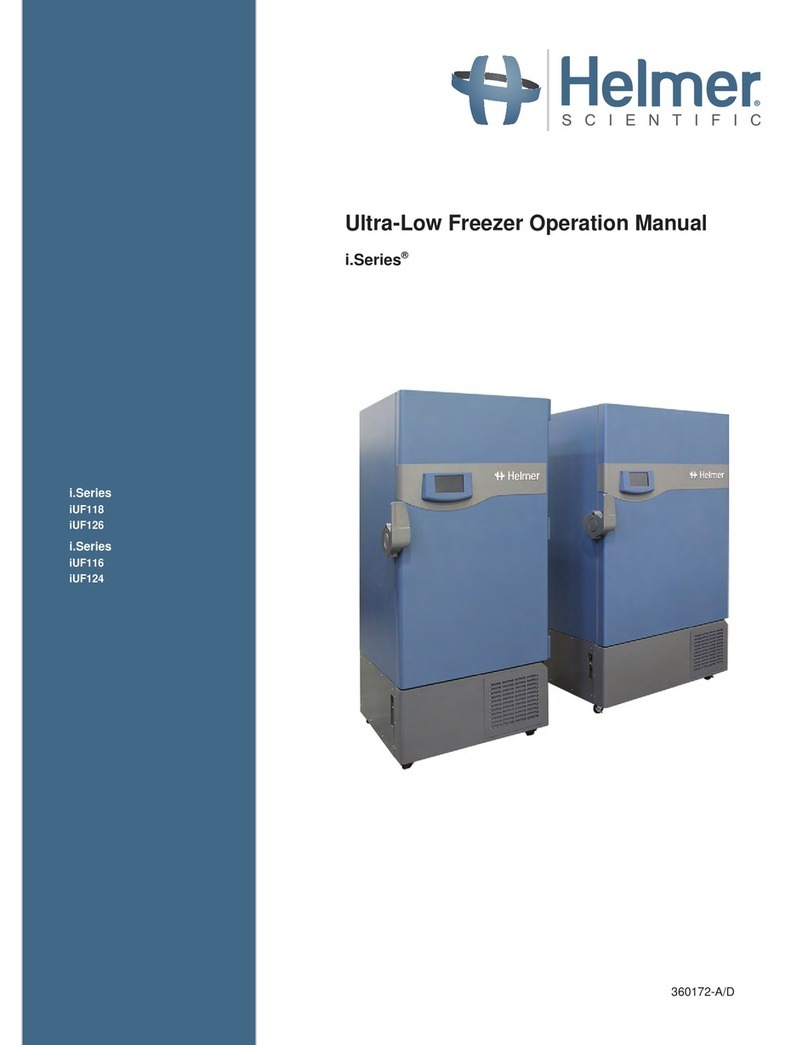
Helmer
Helmer i.Series iUF118 Operation manual
Electrolux
Electrolux E32AF75FPS - Icon - Refrigerator Service data sheet

Fisher & Paykel
Fisher & Paykel ACTIVESMART RF730Q user guide
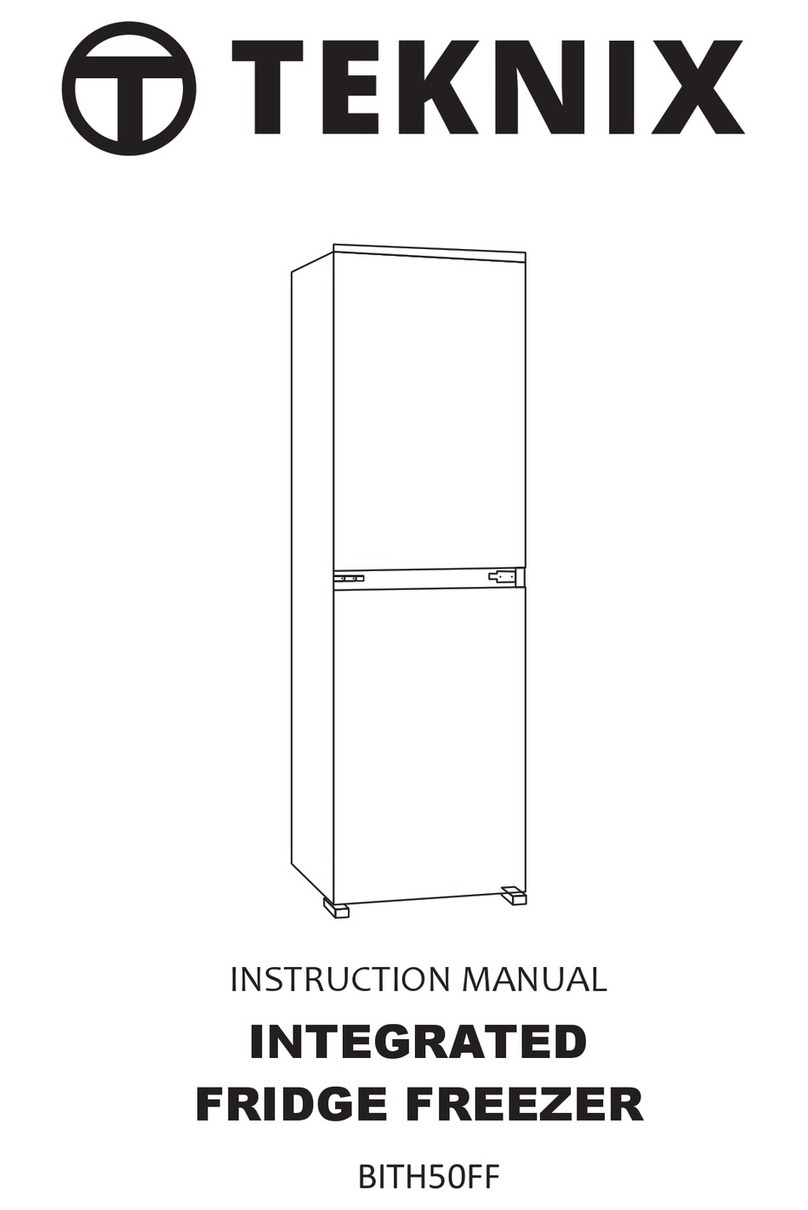
TEKNIX
TEKNIX BITH50FF instruction manual
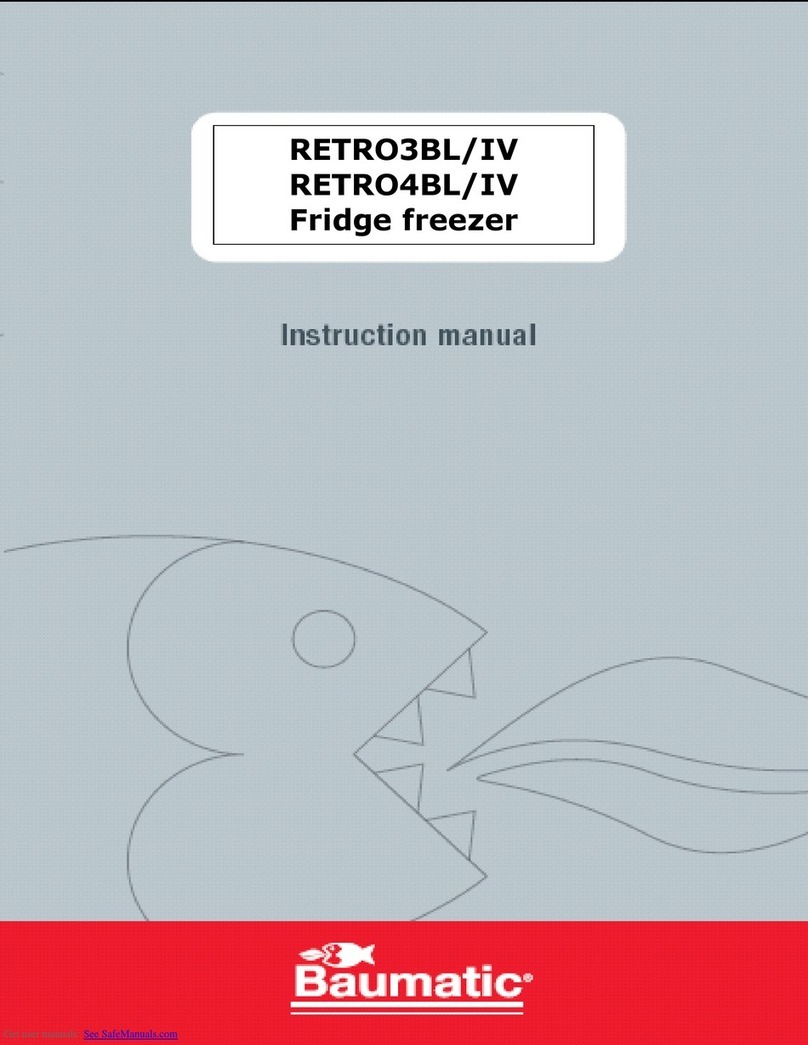
Baumatic
Baumatic RETRO3BL/IV instruction manual
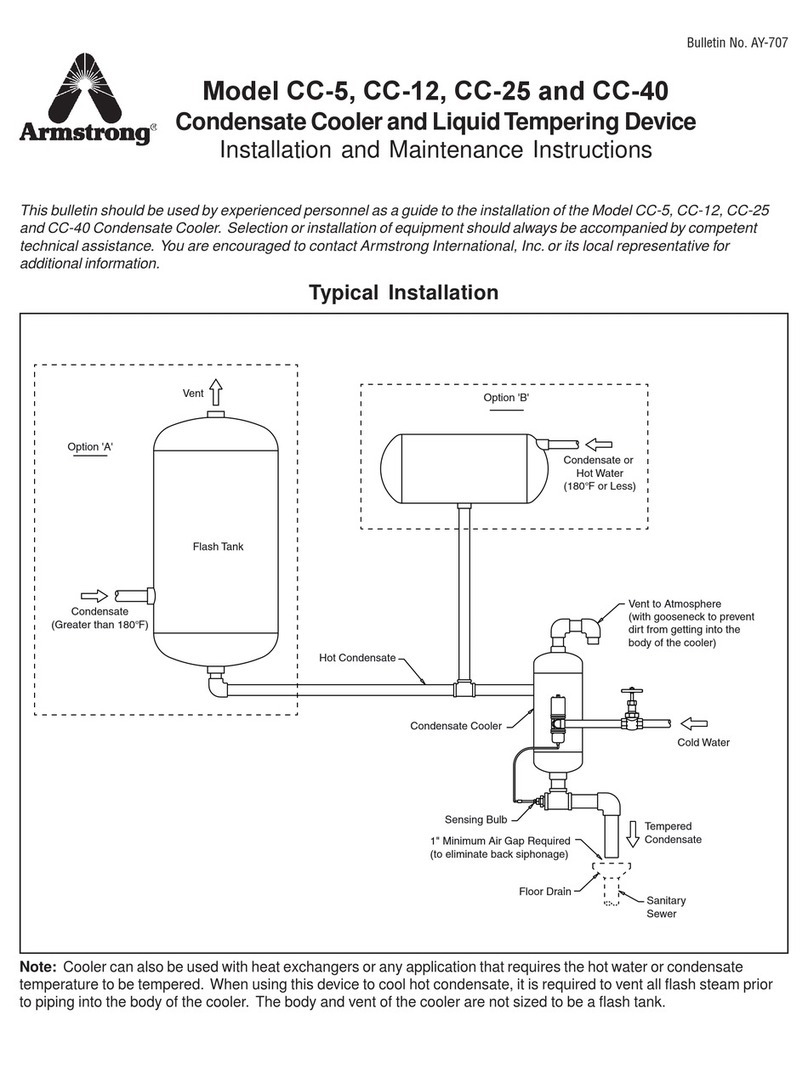
Armstrong
Armstrong CC-5 Installation and maintenance instructions
